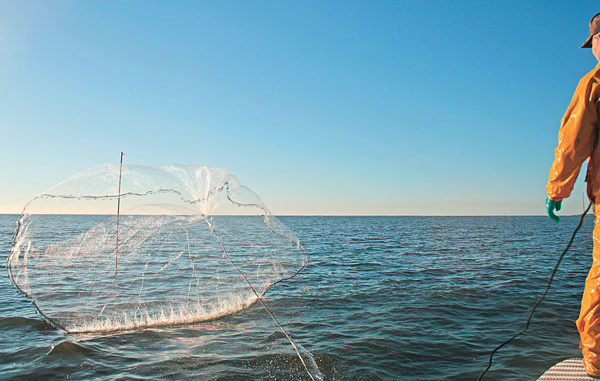
Do your homework, pay attention and harvest the coast’s tastiest bounty.
South Carolina sportsmen have a penchant for loving “Opening Day.” And during the fall, many such opportunities occur in the Palmetto State. With varied deer seasons and dove seasons opening, plenty of anticipation is in the air. But many sportsmen anticipate the Opening Day of shrimp-baiting season with the same intensity.
Passionate about the sport and enamored with the eating qualities of shrimp, many outdoorsmen plan their fall outdoor pursuits around this coastal sport.
The practice of shrimping using cast nets without bait is not restricted by a season, but there is a specific season for employing bait to help attract and catch shrimp.
Rev. Bob Matthews of Ladson, employs both techniques to catch shrimp. But he most eagerly awaits the shrimp-baiting season.
“Shrimpers have found that the shrimp-catching process is much more productive and fun during shrimp-bating season,” Matthews said. “I’ve found that the shrimp-baiting season is the prime time to load the freezer with some of the best of all the Lord’s bounty we can gather from the sea.”
According to Matthews, this bounty maybe gathered many different ways, but there are some common elements for consistent success.
“One of the aspects of the shrimp-baiting season is that it’s basically a 2-man team affair,” he said. “While I and many of my friends can do it alone, it is easier with two people and typically much more enjoyable in terms of fellowship with a friend.”
The team is essentially one person to drive the boat and one to cast the net.
“I enjoy use the big nets, the 8-, 9- and 10-foot radius cast nets,” Matthews said, “but to do that, especially on windy days, I need a good boat driver. It’s obvious that you’ve got to have a skilled person throwing the net, but a good boat driver who keeps the cast-net person in just the right position to make a good throw is essential.”
The mechanics of shrimping over bait is simple, but essential. Mike Cox of Awendaw is another hard-core shrimper who sometimes teams up with Matthews. More often, they work together in two different boats when looking for shrimp, often communicating by cell phone when one finds an area loaded with shrimp.
“The basic philosophy is to determine where you want to shrimp,” Cox said. “Depending on the tide, the best locations will vary. For example, on a high but dropping tide, setting up near grass lines can be good to catch shrimp as the leave the grass and retreat to deeper water. When the tide is low but rising, I’ll often set up along the edges of deeper holes and try to catch the shrimp as they move out of the deep holes and back toward shallower areas. I put out my 10 poles and place the bait balls around the poles to attract the shrimp, then cast the net over the bait and haul the shrimp aboard.”
Cox said that is the simplistic version of the process.
“I place a high emphasis on getting just the right setup,” Cox said. “It’s essential that the direction of the tide, incoming or outgoing, be factored with the prevailing wind conditions when placing the poles. You want to set up so the wind and tide work for you, not against you”
Cox calculates the tide when placing poles. If the tide is high and falling, he places the poles in places where there will still be enough water as the tide gets low. The reverse is true on a rising tide; he places the poles where they will not be submerged when the tide peaks out. The poles Cox uses are generally 12 to 13 feet long.
“That enables me to cover most rising- and falling-tide situations,” he said. “Once the poles are set, you toss bait balls equal distance from the poles. That distance should correlate to the size of net you use. I like a 6- or 7-foot net, and I will place my bait where an open net is centered over the bait and the outside edge of the net lands about a foot from the pole. If I set up properly as the boat operator positions the boat for the next pole, all I have to focus on is making a good cast. My bait will be in the same relative position from each pole. Hitting the bait with the cast net is crucial to catching shrimp.”
Cox said the best shrimping will be on a moving tide, and the slowest will be on the slack-water time between tides.
“There are places that are best on rising tides, others on a dropping tide,” he said, “but having a good tide moving water in one direction or the other is the one factor that is typically essential. Also, while we do most of our shrimping by day, with a good lighting system, the nocturnal hours are also very productive.”
The bait is another key component to the plan, Matthews said.
“The balls typically consist of ground-up fish meal, such as menhaden, mixed with a clayish mud in the form of a baseball-sized mud ball,” he said.”Some (people) like to put a bit of a flatter, pancake finish on them so they won’t roll with the tide when tossed into the water. We’ll usually put two or three out when we start and refresh the bait as needed if the number of shrimp starts to trickle down. As the fish meal leaches out of the mud, the shrimp are attracted to the scent, congregating the shrimp in a small, localized area.”
While a good system is critical, the exact place you shrimp is also crucial. According to Matthews, the right location can change daily.
“I’ve seen the hot spots change from one day to the next very dramatically,” he said. “That was precisely the case during the 2009 season. We would catch a limit in a specific place, and then go back the next day to the same spot and catch almost nothing.”
The good news is that sometimes, the shrimp will hold in the same general area for a while, according to Matthews.
“When I find shrimp, and I go back the next day on a similar tide, I’ll certainly start at about the same place,” he said. “Often, that’s all we’ll have to do, or we may have to move a couple hundred yards one way or the other. In some areas, you’ll find shrimp on the flats near the grass, and sometimes they’ll be found in better numbers and sizes near channel drops. One of the best known but always productive areas is right in the Charleston Harbor. But the creeks, inlets and bays north and south of Charleston can be excellent.”
Cox said almost any sizable creek or bay has the potential to hold shrimp. One way he locates a productive area is to stick one or two poles in a promising spot, add a bait ball or two and wait a few minutes. Then he will cast the net on the bait, and if he catches some shrimp, he will stick the rest of the poles and bait them. If not, he will move and try again elsewhere.
“It’s a bit more work, but this way, once you set up you can be more certain there are shrimp in the area and make a commitment to that place,” he said. “By commitment, I refer to both spending time and loading it up with bait.”
“If you shrimp enough, you’ll eventually find some honey holes that will be productive every year at about the same time.”
Matthews said that while limits sometimes come quick for the experts, newcomers may have to work a bit harder and exercise patience.
“Often it is a combination of two things,” he said. “First is simply having the process down-pat. Going shrimping a lot and staying in touch with the location of the shrimp is a big plus. Second, after several years of experience, shrimpers develop a process of considering the existing weather, tide and water conditions and can deduce productive alternative plans.”
Both Matthews and Cox agree that the key to consistent success is preparation mixed with plenty of good old-fashioned hard work. But the reward is some of Mother Nature’s tastiest bounty from the sea.

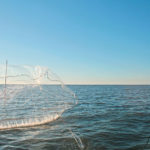
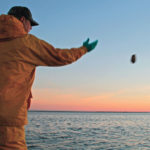
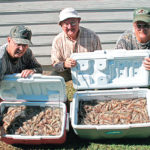
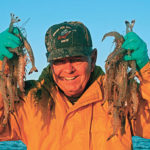



Be the first to comment